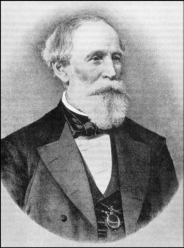- MULVANY W T
- IRELAND (see also List of Individuals)\
 11.3.1806 Dublin/IE - 30.10.1885 Düsseldorf/D\William Thomas Mulvany started his studies in medicine at Dublin University but was unable to graduate because of financial problems. He thus became surveyor and advanced in the 1830s to civil engineer of the city of Limerick. In 1842 he was appointed inspector of drainage and fisheries, and to inspector of public works in 1846. He left public service in 1853, however, because his impermanent position in the Irish government. From London, he was invited to collaborate with mines in Germany, leading in 1855 to his emigration to Düsseldorf. There he contributed to the wealth of the Ruhr mining region that developed in the 1860s. Compared to the English mining techniques, those of the Ruhrtal lagged significantly behind and thus offered Mulvany possibilities for improvement. During this time Mulvany was not only an important technical adviser but also a friend of the miners and their families. He was elected president of the mining company of Rheinland and Westfalen and a founding member of Verein Deutscher Eisenund Stahlindustrieller. He was also awarded honorary citizen of Gelsenkirchen in the German mining region.\Mulvany professionally had thus two different periods, of which the first is here of relevance. During his engineering days in Ireland, he was interested in drainage works, river and land improvements. In the difficult years around 1850 in Ireland, he proposed the navigability of River Shannon. He and his brother Thomas John are remembered as the fathers of the rational formula in hydrology, according to which runoff on a certain surface is equal to the rainfall intensity times the watershed area times a runoff coefficient, a basic relation that is often credited to Emil Kuichling (1848-1914).\Bueck, H.A. (1885). William Thomas Mulvany. Stahl und Eisen 5(12): 820-821. PDooge, J.C.I. (1987). Manning and Mulvany - River improvement in 19th century Ireland. Hydraulics and hydraulic research: 173-183, G. Garbrecht, ed. Balkema: Rotterdam. Kuichling, E. (1889). The relation between rainfall and the discharge in sewers in populous dis- tricts. Trans. ASCE 20: 1-60.Mulvany, T.J. (1851). On the use of self-registering rain and flood gauges in making observations of the relations of rainfall and of flood discharges in a catchment. Trans. Institution Civil Engineers Ireland 4(II): 18-33.Serlo, W. (1938). William Thomas Mulvany, die mit ihm versippte Familie Seebohm. Westdeutsche Bergund Hüttenleute und ihre Familien: 1-17. Glückauf: Essen. P http://www.ruhrbergbau.de/sections.php?op=viewarticle&artid=36 P
11.3.1806 Dublin/IE - 30.10.1885 Düsseldorf/D\William Thomas Mulvany started his studies in medicine at Dublin University but was unable to graduate because of financial problems. He thus became surveyor and advanced in the 1830s to civil engineer of the city of Limerick. In 1842 he was appointed inspector of drainage and fisheries, and to inspector of public works in 1846. He left public service in 1853, however, because his impermanent position in the Irish government. From London, he was invited to collaborate with mines in Germany, leading in 1855 to his emigration to Düsseldorf. There he contributed to the wealth of the Ruhr mining region that developed in the 1860s. Compared to the English mining techniques, those of the Ruhrtal lagged significantly behind and thus offered Mulvany possibilities for improvement. During this time Mulvany was not only an important technical adviser but also a friend of the miners and their families. He was elected president of the mining company of Rheinland and Westfalen and a founding member of Verein Deutscher Eisenund Stahlindustrieller. He was also awarded honorary citizen of Gelsenkirchen in the German mining region.\Mulvany professionally had thus two different periods, of which the first is here of relevance. During his engineering days in Ireland, he was interested in drainage works, river and land improvements. In the difficult years around 1850 in Ireland, he proposed the navigability of River Shannon. He and his brother Thomas John are remembered as the fathers of the rational formula in hydrology, according to which runoff on a certain surface is equal to the rainfall intensity times the watershed area times a runoff coefficient, a basic relation that is often credited to Emil Kuichling (1848-1914).\Bueck, H.A. (1885). William Thomas Mulvany. Stahl und Eisen 5(12): 820-821. PDooge, J.C.I. (1987). Manning and Mulvany - River improvement in 19th century Ireland. Hydraulics and hydraulic research: 173-183, G. Garbrecht, ed. Balkema: Rotterdam. Kuichling, E. (1889). The relation between rainfall and the discharge in sewers in populous dis- tricts. Trans. ASCE 20: 1-60.Mulvany, T.J. (1851). On the use of self-registering rain and flood gauges in making observations of the relations of rainfall and of flood discharges in a catchment. Trans. Institution Civil Engineers Ireland 4(II): 18-33.Serlo, W. (1938). William Thomas Mulvany, die mit ihm versippte Familie Seebohm. Westdeutsche Bergund Hüttenleute und ihre Familien: 1-17. Glückauf: Essen. P http://www.ruhrbergbau.de/sections.php?op=viewarticle&artid=36 P
Hydraulicians in Europe 1800-2000 . 2013.
